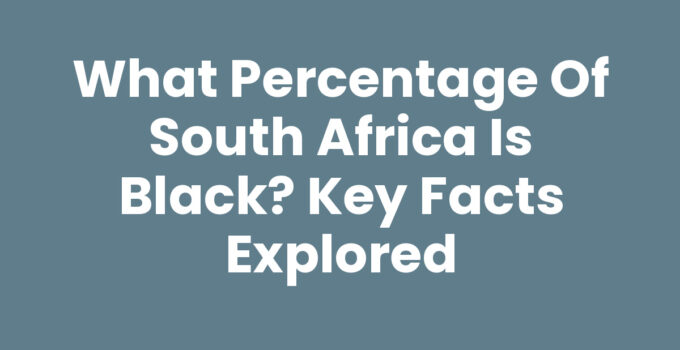South Africa is known for its rich cultural diversity and complex history. In the post-apartheid era, the country has made significant strides toward social cohesion and equality. A critical element of understanding this societal landscape is its demographics, particularly the racial composition of its population. In this article, we will explore the percentage of the black population in South Africa, along with related demographic insights.
What Percentage of South Africa is Black?
As of the latest data from the Statistics South Africa census, approximately 80.2% of the population identified as Black African. This statistic reflects the various ethnic groups that belong to the black demographic in the country, including Zulu, Xhosa, Sotho, and Tswana, among others. Understanding this percentage is crucial for grasping the socio-economic dynamics in South Africa.
The census data is collected every ten years, with the most recent survey conducted in 2021 revealing a total population of over 60 million people. The black population is the largest demographic group, followed by white, colored, and Indian/Asian groups. This composition plays a significant role in shaping the cultural, political, and economic landscape of the nation.
In addition to the raw percentage, it is essential to look at how this demographic has evolved over time. Historically, black South Africans have faced significant oppression and inequality under apartheid, which has left lasting scars on the society. Today, the government continues to prioritize policies that aim to address these historical disparities, including affirmative action and land reform initiatives.
Recommended Reading: Top Halaal Restaurants in Bloemfontein You Must Try
Understanding the Importance of Racial Demographics
Racial demographics go beyond mere numbers; they are reflective of the historical, social, and economic frameworks within a country. In South Africa, understanding the demographics is vital for several reasons:
- Policy Making: Accurate demographic data allows policymakers to create laws and programs that address the needs of the majority populace.
- Cultural Representation: Increased awareness of the demographic landscape fosters representation in media, government, and business.
- Social Cohesion: Recognizing and valuing diversity can lead to enhanced mutual respect and understanding among different racial groups.
By thoroughly understanding the percentage of different groups, including the dominant black population, resources can be allocated more effectively, ensuring that all members of society have the opportunity to thrive.
Related Guide: Can I Drink South African Water? Essential Guide for Travelers
The Role of Education and Economic Participation
Economic participation and education levels among South Africa’s black population have improved, yet challenges remain. Despite comprising the majority, black South Africans historically have had less access to quality education and economic opportunities due to systemic inequalities. Today’s government initiatives aim to bridge these gaps by investing in education and supporting black-owned businesses.
Programs such as free tertiary education for students from low-income families and various skills development initiatives are designed to uplift the black majority and promote socio-economic empowerment. Evaluating the impact of these programs is essential for future policies and the continuous effort towards creating an equitable society.
Recommended Guide: A Comprehensive Guide to Bloemfontein for Students
Conclusion
Understanding what percentage of South Africa is black is more than merely acknowledging a statistic; it’s about recognizing the context, struggles, and advancements that have shaped this demographic group. As South Africa moves forward, the collective efforts towards equality, representation, and socio-economic upliftment are vital. Armed with this knowledge, we can better appreciate South Africa’s rich diversity and work together towards a brighter future for all its citizens.
Check This: Discover Exciting Exhibitions in Bloemfontein Today
Frequently Asked Questions
What is the current black population percentage in South Africa?
As of the latest census, approximately 80.2% of South Africa's population is Black African.
How does the racial demographic impact socio-economic policies?
Racial demographics influence policy decisions that aim to address historical inequalities and ensure equitable resource distribution.
What initiatives does the government have for black South Africans?
The South African government has introduced various initiatives such as skills development programs and educational reforms to empower the black population.



